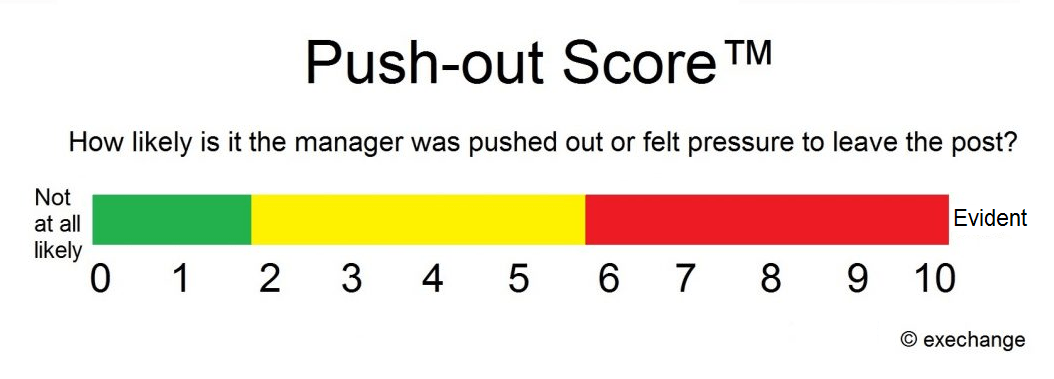
Limitations of the Push-out Score™
Like all systems, the Push-out Scoring System™ has its limitations. The Push-out Score condenses a complex situation into a single score. This has advantages and disadvantages.
- Opinion, not fact. The input data to the Push-out Scoring System are facts. The output of the Push-out Scoring System is an opinion. Opinions are debatable, but neither deniable nor negotiable. A relatively high Push-out Score indicates a high likelihood that the manager was pushed out or may have felt relatively high pressure to leave the position. It does not indicate that a manager was actually pushed out.
- Theoretical construct. The Push-out Scoring System is based on the assumption that management changes are triggered by pull-out forces and push-out forces. The method was inspired by the push and pull factors theory in migration research. Push-out forces and pull-out forces are a theoretical construct. The nine criteria Form, Language, Age, Notice period, Tenure, Share price, Official reason, Circumstances and Succession are proxy variables. A proxy variable is an easily measurable variable that is used in place of a variable that cannot be measured or is difficult to measure. Push-out forces and pull-out forces are ultimately unobservable and immeasurable, just like pain, grief or joy. In this regard, the Push-out Scoring System has similar limitations as behavioral pain assessment tools, grief assessment tools or joy assessment tools.
- Missing data. The Push-out Scoring System can only take into account available data. Missing data may lead to doubtful results. For a meaningful result, signs of push-out forces and signs of pull-out forces have to be considered together. In particular, pull-out forces are often difficult to evaluate. To give an example: It is clear that a carefully designed career rise should be classified as pull-out force. On the other hand, it is not clear whether the prospect “to spend more time with the family” can be considered as pull-out force. The phrase has been damaged by frequent abuse.
- Never completely error-free. The Push-out Scoring System uses seven hard indicators (Age, Notice period, Tenure, Share price development, Official reason given, Circumstances, Succession) and two soft indicators (Form of the announcement, Language in the announcement). A system based on quantification of ultimately non-quantifiable factors is by its nature never completely error-free. Soft indicators, especially language, are extremely difficult to objectify. Therefore, exechange works with the support of proprietary natural language processing (NLP) tools to assess phrases. Moreover, exechange works with proprietary natural language generation (NLG) tools to be able to present results in a language that is demonstrably free of bias (even unconscious bias), irony, sarcasm and cynicism.
- Personal judgment. There are no rigid rules to assess the Push-out Score. Assessments are made on a case-by-case basis. To give three examples: An age of 58, a tenure of two years or a relatively poor share price performance may be considered appropriate or inappropriate, depending on the situation. Depending on personal judgment, preferences and criteria, the Push-out Score can differ.
- No ultimate truth. The Push-out Scoring System enhances transparency. It was not designed to find “the ultimate truth.” In our view, there is no such thing as the ultimate truth. Facts are not debatable. Truth may be debatable. There are many truths.
- Things are not always what they seem. Last but not least: Things are not always what they seem. No matter how carefully we assess the case, residual doubt will remain. We know what people say and what they do. We don’t know what they think and what they intend. And we don’t know for sure what is real and what is fake. To give an extreme example: Even when we see the CEO literally being pushed out the door, fighting tooth and nail, it may be an intentionally provoked firing — or just a big show.
